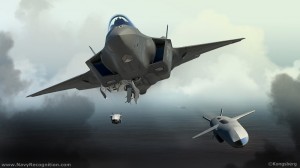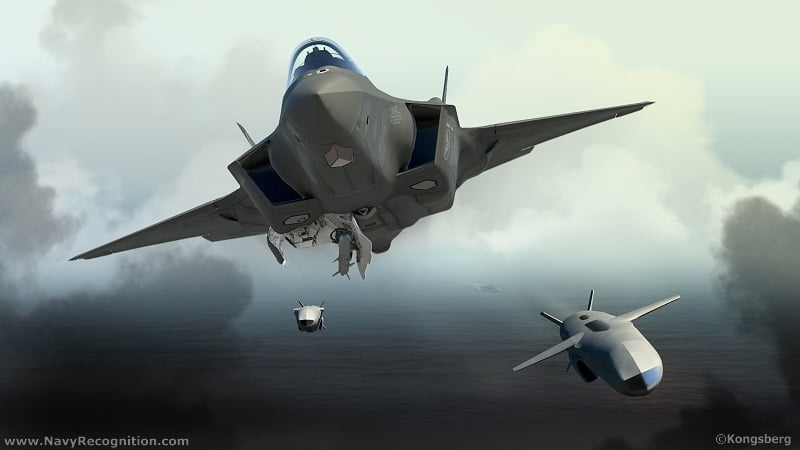2017-06-29 During a visit to Norway earlier this year, the Norwegian Deputy Minister of Defense underscored the importance of allies building new missile capabilities for the F-35 as a coalition aircraft.
In the discussion with Mr. Øystein BØ, the State Secretary and Deputy Defense Minister at the Norwegian Ministry of Defense, the F-35 and the Norwegian JSM was discussed as follows:
An aspect of the F-35 program, which is not generally realized, is the importance of allied investments in capabilities, which can be used across the F-35 global enterprise.
In the Norwegian case, the Joint Strike Missile (JSM), which is considered a crucial asset in providing for maritime defense of Norway, is available to other NATO-allies flying the F-35 as well.
“This is a 21st century aspect of burden sharing as our investments in ‘our’ missile benefits all F-35 users of this missile across the globe, whether in Japan, Australia or in Europe.”
“It is not money that just goes directly into our armed forces, but it’s a lot of money that goes into developing capabilities that the alliance needs. It is about contributing to our joint security as well.”

In April 2017, the Australian Department of Defence signed on with Kongsberg to work on the JSM.
According to Australian Aviation:
Kongsberg Defence Systems has entered into a contract with Defence for the integration of a new capability in the Joint Strike Missile (JSM) worth the equivalent of $23 million.
The unique, state-of-the-art radio frequency (RF) seeker sensor developed by BAE Systems Australia will enable the JSM to locate targets on the basis of their electronic signature, Kongsberg said in a statement.
This contract is a result of an agreement between Australia and Norway to cooperate on the further development of the JSM that was announced in February 2015.
“JSM is the fifth-generation long-range precision strike missile that will be integrated for internal carriage on the F-35,” Kongsberg stated. “Using a combination of advanced materials, ability to fly low, while following the terrain and using advanced passive seekers, the missile is extremely difficult to detect and stop, even for the most advanced countermeasures and defence systems.”
BAE Systems stated that the signing of the contract will enable Kongsberg to continue the integration and qualification of the passive RF sensor.
“The company will provide a low-cost, lightweight and highly sensitive electronic support measure receiver for incorporation on JSM, which will feature an additional land attack and littoral attack capability, as well as a two-way communications line for target adjustment and inflight termination,” BAE Systems stated.
“In its work with Kongsberg, BAE Systems has delivered a pre-production passive RF sensor for the JSM program, which was used to perform fit checks, system integration and support flight-testing in a development-standard missile.”
In support of the contract, BAE Systems will supply new sensors to Kongsberg for use in its qualification activities.
“This is a great example of niche technology being developed through government and industry collaboration that has the potential to provide long-term, sustainable exports for Australia,” said BAE Systems Australia chief executive Glynn Phillips.
The company stated that the technology was developed with the support of a Defence-funded program, and that it received a grant in 2013 to help commercialise the technology.
“We are very pleased that Australia joins the development of JSM by funding the integration of the RF seeker, and that we together can increase the JSM capabilities,” said Eirik Lie, president of Kongsberg Defence Systems.
Now Japan is moving forward in considering JSM for its own F-35s as a land attack and naval attack component for its air combat force.
According to a June 26, 2017 article published by Yomiuri Shimbun, the Japanese Government mulls equipping F-35s with air-to-surface missiles.
The government is considering equipping cutting-edge F-35 stealth fighters with air-to-surface missiles, which are capable of striking remote targets on land, and plans to deploy these fighters to the Air Self-Defense Force, The Yomiuri Shimbun has learned.
It will become the first introduction of such missiles for the Self-Defense Forces. The government hopes to allocate relevant expenses in the fiscal 2018 budget, according to sources close to the government. The main purpose of the introduction is to prepare for emergencies on remote Japanese islands, while some experts believe the government is also eyeing possession of the capability of attacking targets such as enemy bases for the purpose of defending the country.
According to the sources, F-35 fighter jets that will replace the ASDF’s F-4 fighter aircraft are employed by U.S. forces and others. The F-35 aircraft has an advanced stealth capability that makes the aircraft less visible on enemy radar. The ASDF plans to introduce a total of 42 units of the F-35 and gradually deploy them to the Misawa Air Base in Aomori Prefecture starting at the end of this fiscal year. The government is considering introducing some additional capabilities for the aircraft.
The most likely option the government is currently focusing on is the Joint Strike Missile (JSM) that is being developed mainly by Norway, which also participated in an international project to develop the F-35. The ASDF currently has no air-to-surface missile capabilities, but the JSM has both air-to-ship and air-to-surface capabilities, with an estimated range of about 300 kilometers.
The Defense Ministry is building up national defense systems to defend remote islands, such as the Nansei Islands. In addition to deploying new Osprey transport aircraft to the Ground Self-Defense Force, the ministry plans to create an amphibious rapid deployment brigade, similar to other nations’ marines.
As an air-to-surface missile has a long range, it is possible to effectively strike a target from safe airspace. For this to be possible, the ministry decided it was necessary to consider introducing the JSM to prepare for situations such as preventing foreign military vessels from approaching remote islands or the SDF launching an operation to regain control of an occupied island.
Meanwhile, if the F-35 aircraft with an advanced stealth capability is equipped with long-range air-to-surface missiles, it will effectively be possible to use the F-35 to attack bases in foreign countries.
The government has said that the Constitution allows Japan to possess the capability of striking enemy bases, but the nation does not actually possess the capability as its political decisions have been based on an exclusively defense-oriented policy.
If Japan introduces air-to-surface missiles, it could prompt opposition from neighboring countries. Therefore, the government is believed to be seeking the understanding of those countries by explaining that it does not intend to use the capability to attack enemy bases, but to defend remote islands.
However, with North Korea continuing its nuclear and missile development programs and repeatedly conducting provocative actions, there are growing calls for the government to possess the capability to strike enemy bases to improve Japan’s deterrence.
Amid such a situation, Prime Minister Shinzo Abe has expressed on multiple occasions his intention to consider the issue. On June 20, the Liberal Democratic Party’s Research Commission on Security compiled an interim report on proposals for the next medium-term defense program for fiscal 2019-23, in which it called for the government to swiftly start discussions on possessing the capability to attack enemy bases.


